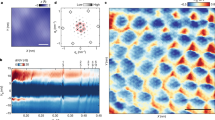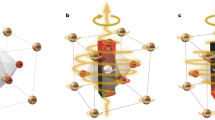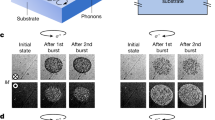Abstract
The Einstein-de Haas effect was originally observed in a landmark experiment1 demonstrating that the angular momentum associated with aligned electron spins in a ferromagnet can be converted to mechanical angular momentum by reversing the direction of magnetization using an external magnetic field. A related problem concerns the timescale of this angular momentum transfer. Experiments have established that intense photoexcitation in several metallic ferromagnets leads to a drop in magnetization on a timescale shorter than 100 femtoseconds—a phenomenon called ultrafast demagnetization2,3,4. Although the microscopic mechanism for this process has been hotly debated, the key question of where the angular momentum goes on these femtosecond timescales remains unanswered. Here we use femtosecond time-resolved X-ray diffraction to show that most of the angular momentum lost from the spin system upon laser-induced demagnetization of ferromagnetic iron is transferred to the lattice on sub-picosecond timescales, launching a transverse strain wave that propagates from the surface into the bulk. By fitting a simple model of the X-ray data to simulations and optical data, we estimate that the angular momentum transfer occurs on a timescale of 200 femtoseconds and corresponds to 80 per cent of the angular momentum that is lost from the spin system. Our results show that interaction with the lattice has an essential role in the process of ultrafast demagnetization in this system.
This is a preview of subscription content, access via your institution
Access options
Access Nature and 54 other Nature Portfolio journals
Get Nature+, our best-value online-access subscription
$29.99 / 30 days
cancel any time
Subscribe to this journal
Receive 51 print issues and online access
$199.00 per year
only $3.90 per issue
Buy this article
- Purchase on Springer Link
- Instant access to full article PDF
Prices may be subject to local taxes which are calculated during checkout



Similar content being viewed by others
Data availability
Raw data were generated at the LCLS large-scale facility, and intermediate datasets were generated during analysis. The raw and intermediate datasets are available from the corresponding author on reasonable request.
References
Einstein, A. & de Haas, W. J. Experimenteller Nachweis der Ampèreschen Molekularströme. Verhandl. Deut. Phys. Ges. 17, 152–170 (1915).
Beaurepaire, E., Merle, J., Daunois, A. & Bigot, J. Ultrafast spin dynamics in ferromagnetic nickel. Phys. Rev. Lett. 76, 4250–4253 (1996).
Carpene, E. et al. Dynamics of electron–magnon interaction and ultrafast demagnetization in thin iron films. Phys. Rev. B 78, 174422 (2008).
Fähnle, M. et al. Review of ultrafast demagnetization after femtosecond laser pulses: a complex interaction of light with quantum matter. Am. J. Phys. 7, 68–74 (2018).
Koopmans, B., Kampen, M. V. & Jonge, W. J. M. D. Experimental access to femtosecond spin dynamics. J. Phys. Condens. Matter 15, S723–S736 (2003).
Stamm, C. et al. Femtosecond modification of electron localization and transfer of angular momentum in nickel. Nat. Mater. 6, 740–743 (2007).
Stamm, C., Pontius, N., Kachel, T., Wietstruk, M. & Dürr, H. A. Femtosecond X-ray absorption spectroscopy of spin and orbital angular momentum in photoexcited Ni films during ultrafast demagnetization. Phys. Rev. B 81, 104425 (2010).
Boeglin, C. et al. Distinguishing the ultrafast dynamics of spin and orbital moments in solids. Nature 465, 458–461 (2010).
Zhang, G. P. & Hübner, W. Laser-induced ultrafast demagnetization in ferromagnetic metals. Phys. Rev. Lett. 85, 3025–3028 (2000).
Töws, W. & Pastor, G. M. Many-body theory of ultrafast demagnetization and angular momentum transfer in ferromagnetic transition metals. Phys. Rev. Lett. 115, 217204 (2015).
Krieger, K., Dewhurst, J. K., Elliott, P., Sharma, S. & Gross, E. K. U. Laser-induced demagnetization at ultrashort time scales: predictions of TDDFT. J. Chem. Theory Comput. 11, 4870–4874 (2015).
Shokeen, V. et al. Spin flips versus spin transport in nonthermal electrons excited by ultrashort optical pulses in transition metals. Phys. Rev. Lett. 119, 107203 (2017).
Battiato, M., Carva, K. & Oppeneer, P. M. Superdiffusive spin transport as a mechanism of ultrafast demagnetization. Phys. Rev. Lett. 105, 027203 (2010).
Eschenlohr, A. et al. Ultrafast spin transport as key to femtosecond demagnetization. Nat. Mater. 12, 332–336 (2013).
Khorsand, A. R., Savoini, M., Kirilyuk, A. & Rasing, T. Optical excitation of thin magnetic layers in multilayer structures. Nat. Mater. 13, 101–102 (2014).
Turgut, E. et al. Controlling the competition between optically induced ultrafast spin-flip scattering and spin transport in magnetic multilayers. Phys. Rev. Lett. 110, 197201 (2013).
Melnikov, A. et al. Ultrafast transport of laser-excited spin-polarized carriers in Au/Fe/MgO(001). Phys. Rev. Lett. 107, 076601 (2011).
Schellekens, A. J., Verhoeven, W., Vader, T. N. & Koopmans, B. Investigating the contribution of superdiffusive transport to ultrafast demagnetization of ferromagnetic thin films. Appl. Phys. Lett. 102, 252408 (2013).
Jaafar, R., Chudnovsky, E. M. & Garanin, D. A. Dynamics of the Einstein–de Haas effect: application to a magnetic cantilever. Phys. Rev. B 79, 104410 (2009).
Mentink, J. H., Katsnelson, M. I. & Lemeshko, M. Quantum many-body dynamics of the Einstein–de Haas effect. Preprint at https://arxiv.org/abs/1802.01638 (2018).
Kittel, C. On the gyromagnetic ratio and spectroscopic splitting factor of ferromagnetic substances. Phys. Rev. 76, 743–748 (1949).
Van Vleck, J. H. The theory of ferromagnetic resonance. Phys. Rev. 78, 266–274 (1950).
Thomsen, C., Grahn, H. T., Maris, H. J. & Tauc, J. Surface generation and detection of phonons by picosecond light pulses. Phys. Rev. B 34, 4129–4138 (1986).
Macdonald, J. E. X-ray scattering from semiconductor interfaces. Faraday Discuss. Chem. Soc. 89, 191–200 (1990).
Mohanlal, S. K. An experimental determination of the Debye–Waller factor for iron by neutron diffraction. J. Phys. C 12, L651–L653 (1979).
Minkiewicz, V. J., Shirane, G. & Nathans, R. Phonon dispersion relation for iron. Phys. Rev. 162, 528–531 (1967).
Stanciu, C. D. et al. Subpicosecond magnetization reversal across ferrimagnetic compensation points. Phys. Rev. Lett. 99, 217204 (2007).
Lambert, C.-H. et al. All-optical control of ferromagnetic thin films and nanostructures. Science 345, 1337–1340 (2014).
Takahashi, Y. K. et al. Accumulative magnetic switching of ultrahigh-density recording media by circularly polarized light. Phys. Rev. Appl. 6, 054004 (2016).
Granitzka, P. W. et al. Magnetic switching in granular FePt layers promoted by near-field laser enhancement. Nano Lett. 17, 2426–2432 (2017).
Lebedev, M. V., Misochko, O. V., Dekorsy, T. & Georgiev, N. On the nature of “coherent artifact”. J. Exp. Theor. Phys. 100, 272–282 (2005).
Radu, I. et al. Laser-induced magnetization dynamics of lanthanide-doped permalloy thin films. Phys. Rev. Lett. 102, 117201 (2009).
Marklund, K. & Mahmoud, S. A. Elastic constants of magnesium oxide. Phys. Scr. 3, 75–76 (1971).
Villars, P. (ed.) Al sound velocity. Pauling file in Inorganic Solid Phases, SpringerMaterials (online database) (Springer, Heidelberg, 2016); available at https://materials.springer.com/isp/physical-property/docs/ppp_003614.
Chollet, M. et al. The X-ray Pump–Probe instrument at the Linac Coherent Light Source. J. Synchrotron Radiat. 22, 503–507 (2015).
Fognini, A. et al. Magnetic pulser and sample holder for time- and spin-resolved photoemission spectroscopy on magnetic materials. Rev. Sci. Instr. 83, 063906 (2012).
Bionta, M. R. et al. Spectral encoding method for measuring the relative arrival time between X-ray/optical pulses. Rev. Sci. Instr. 85, 083116 (2014).
Herrmann, S. et al. CSPAD-140k: a versatile detector for LCLS experiments. Nucl. Instr. Meth. A 718, 550–553 (2013).
Born, M. & Wolf, E. Principles of Optics Electromagnetic Theory of Propagation, Interference and Diffraction of Light 7th edn (Cambridge Univ. Press, Cambridge, 1999).
Palik, E. Handbook of Optical Constants of Solids (Academic Press, San Diego, 1991).
Ordal, M. A., Bell, R. J., Alexander, R. W., Newquist, L. A. & Querry, M. R. Optical properties of Al, Fe, Ti, Ta, W, and Mo at submillimeter wavelengths. Appl. Opt. 27, 1203–1209 (1988).
Lai, W., Rubin, D., Krempl, E. & Rubin, D. Introduction to Continuum Mechanics (Butterworth-Heinemann, Burlington, 2009).
Pezeril, T., Leon, F., Chateigner, D., Kooi, S. & Nelson, K. A. Picosecond photoexcitation of acoustic waves in locally canted gold films. Appl. Phys. Lett. 92, 061908 (2008).
Woods, A. Inelastic Scattering of Neutrons in Solids and Liquids Vol. 2, 3 (International Atomic Energy Agency, Vienna, 1963).
Flocken, J. W. & Hardy, J. R. Application of the method of lattice statics to vacancies in Na, K, Rb, and Cs. Phys. Rev. 177, 1054–1062 (1969).
Sutton, A. & Hume-Rothery, W. The lattice spacings of solid solutions of titanium, vanadium, chromium, manganese, cobalt and nickel in α-iron. Lond. Edinb. Dubl. Phil. Mag. 46, 1295–1309 (1955).
Dinsdale, A. SGTE data for pure elements. Calphad 15, 317–425 (1991).
Nix, F. C. & MacNair, D. The thermal expansion of pure metals: copper, gold, aluminum, nickel, and iron. Phys. Rev. 60, 597–605 (1941).
Adams, J. J., Agosta, D. S., Leisure, R. G. & Ledbetter, H. Elastic constants of monocrystal iron from 3 to 500 K. J. Appl. Phys. 100, 113530 (2006).
Lindenberg, A. M. Ultrafast Lattice Dynamics in Solids Probed by Time-resolved X-ray Diffraction. PhD thesis, Univ. California, Berkeley (2001).
Meija, J. et al. Atomic weights of the elements 2013 (IUPAC technical report). Pure Appl. Chem. 88, 265–291 (2016).
Crangle, J. & Goodman, G. M. The magnetization of pure iron and nickel. Proc. Royal Soc. Lond. A 321, 477–491 (1971).
Vaz, C. A. F., Bland, J. A. C. & Lauhoff, G. Magnetism in ultrathin film structures. Rep. Progr. Phys. 71, 056501 (2008).
Acknowledgements
Time-resolved X-ray diffraction measurements were carried out at the XPP endstation at LCLS. Use of the Linac Coherent Light Source (LCLS), SLAC National Accelerator Laboratory, is supported by the US Department of Energy, Office of Science, Office of Basic Energy Sciences under contract number DE-AC02-76SF00515. Preparatory static diffraction measurements were performed at the X04SA beamline of the Swiss Light Source. We acknowledge financial support by the NCCR Molecular Ultrafast Science and Technology (NCCR MUST), a research instrument of the Swiss National Science Foundation (SNSF). E.A. acknowledges support from the ETH Zurich Postdoctoral Fellowship Program and from the Marie Curie Actions for People COFUND programme. E.M.B. acknowledges funding from the European Commission’s Seventh Framework Programme (FP7/2007-2013) under grant agreement number 290605 (PSI-FELLOW/COFUND). M.P. acknowledges support from NCCR MARVEL, funded by the SNSF.
Reviewer information
Nature thanks P. G. Evans, M. Münzenberg and S. Sharma for their contribution to the peer review of this work.
Author information
Authors and Affiliations
Contributions
C.D. and S.L.J. conceived and designed the experiment. C.A.F.V. performed the sample fabrication. C.D., M.S., M.K., M.J.N., E.A., L.H., E.M.B., M.P., V.E., L.R. and Y.W.W. performed synchrotron measurements to characterize the sample and prior sample candidates. M.B. and C.D. built the electromagnet. Y.A. built and programmed the pulser for the magnet. A.A. assisted C.D. in analysing X-ray reflectivity measurements of sample candidates. M.S., C.A.F.V., L.H., E.A., G.L., H.L., M.B., P.B. and U.S. gave input to C.D. and S.L.J. on the experimental design and during data analysis. C.D., Y.A., M.S., M.K., H.L., E.M.B., M.P., U.S. and S.L.J. performed the experiment with the help of D.Z., S.S. and J.M.G., the LCLS beamline staff. C.D. and S.L.J. wrote the manuscript and all authors contributed to its final version.
Corresponding authors
Ethics declarations
Competing interests
The authors declare no competing interests.
Additional information
Publisher’s note: Springer Nature remains neutral with regard to jurisdictional claims in published maps and institutional affiliations.
Extended data figures and tables
Extended Data Fig. 1 Optical pump–probe measurements of the sample magnetization at varying incident fluence.
The individual traces have been offset for clarity. These results were taken by recreating the geometric conditions of the X-ray experiment, that is, the laser spot size and angle of incidence were identical. At the highest fluence, laser damage was evident, and the static MOKE signal of the damaged area was permanently lower afterwards.
Extended Data Fig. 2 Maximum relative demagnetization as a function of fluence.
From the traces in Extended Data Fig. 1, the magnitudes of demagnetization just after the coherent artefact (0.4–0.7 ps) were extracted. A linear fit (excluding the highest fluence where damage was evident) captures the observed behaviour well. The fluence in the X-ray experiment was 8.0 ± 0.3 mJ cm−2, corresponding to a demagnetization of 10%.
Extended Data Fig. 3 Goodness of fit, assessed by χ2, for different combinations of angular momentum transfer time and magnitude.
The left panel has a coarse logarithmic axis for the transfer time, whereas the right panel has a linear scale for a more precise determination of the optimum. The optima are indicated by the red crosses; for the coarse scale, the best χ2 of 628.9 is reached for the simulation with 100 fs transfer time and 7% magnitude. For the fine scale, the best values are 200 fs and 8%, with a χ2 of 618.8. The traces in Fig. 2 were generated using the latter parameters.
Extended Data Fig. 4 Snapshots of simulated velocity, displacement and strain in the transverse and longitudinal direction at different times.
The iron film is indicated by grey shading; to the left are the Al and MgO capping layers and to the right is the MgAl2O4 substrate.
Extended Data Fig. 5 Magnetic difference signal plots and two ‘virtual’ control measurements with the same magnetization sign.
The three vertical panels of each set show the three qz ranges centred at 0.0737, 0.0482 and 0.0236 reciprocal lattice units, as in Fig. 2. We constructed the ‘M+’ virtual control dataset by taking only the M > 0 data from each of the 158 scans. Data analysis was then performed by taking the difference of all even and all odd scan numbers. The ‘M−’ control dataset was created in the same manner by using only the M < 0 shots. We note that the uncertainties on both control sets are larger than for the actual magnetic difference data, because each control set uses only half of the total data. These control measurements are also more strongly influenced by longer-term drifts in the alignment of the free electron laser (there were about 4 min between consecutive scans), leading to some noise correlations. Nevertheless, all control sets are consistent with no signal.
Rights and permissions
About this article
Cite this article
Dornes, C., Acremann, Y., Savoini, M. et al. The ultrafast Einstein–de Haas effect. Nature 565, 209–212 (2019). https://doi.org/10.1038/s41586-018-0822-7
Received:
Accepted:
Published:
Issue Date:
DOI: https://doi.org/10.1038/s41586-018-0822-7
This article is cited by
-
Phononic switching of magnetization by the ultrafast Barnett effect
Nature (2024)
-
Terahertz electric-field-driven dynamical multiferroicity in SrTiO3
Nature (2024)
-
Light makes atoms behave like electromagnetic coils
Nature (2024)
-
A spin–rotation mechanism of Einstein–de Haas effect based on a ferromagnetic disk
Frontiers of Physics (2024)
-
Spin current driven by ultrafast magnetization of FeRh
Nature Communications (2023)
Comments
By submitting a comment you agree to abide by our Terms and Community Guidelines. If you find something abusive or that does not comply with our terms or guidelines please flag it as inappropriate.



